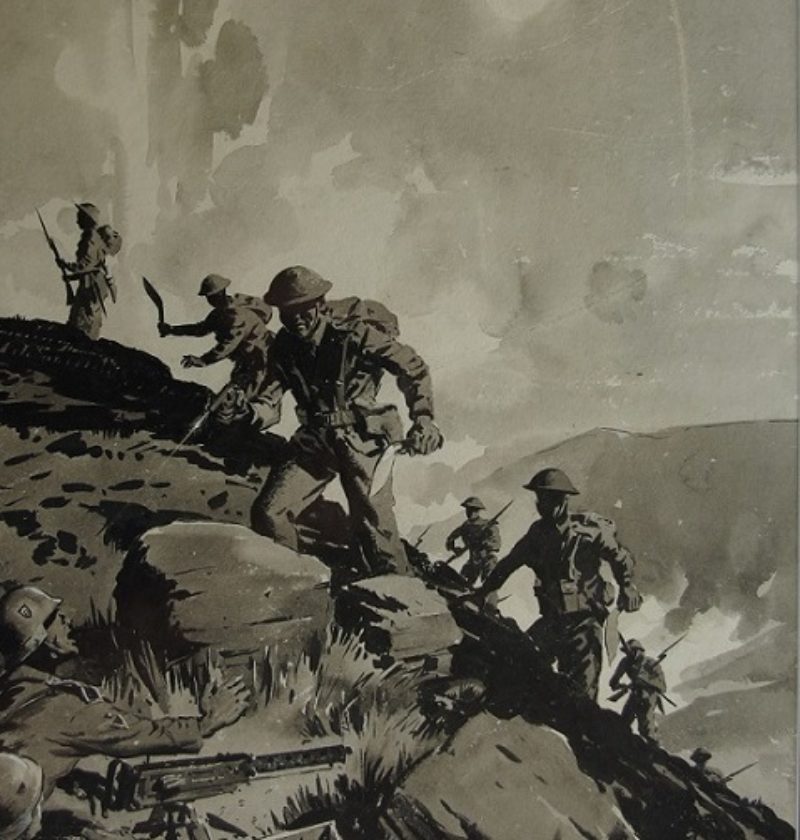Subedar Lalbahadur Thapa V.C. and the Battle of Wadi Akarit

Subedar Lalbahadur Thapa V.C. and the Battle of Wadi Akarit
The first award of a Victoria Cross to a Gurkha soldier during the Second World War was to Subedar Lalbahadur Thapa of 2nd King Edward VII’s Own Gurkha Rifles (the Sirmoor Rifles). The action that led to has award took place over the 5th and 6th of April 1943 at Wadi Akarit in Tunisia. To allow the Allied 8th Army to wheel round behind the Axis forces commanded by Erwin Rommel, 4th Indian Division, of which Lalbahadur’s unit formed part, was directed to make a night assault to take a feature known as the Fatnassa heights. Lalbahadur led two sections of Gurkhas in this assault, overpowering many of the outlying enemy positions using bayonet and kukri alone. They were eventually discovered however, and subjected to very heavy small-arms fire. Lalbahadur led his men in a charge up the heights, taking out machine gun posts as they went, until he and two riflemen reached the summit of the heights, putting the Axis troops to flight.
His citation reads:
“On the night of 5th/6th April, 1943, during the silent attack on the Rass-Ez-Zouai feature, Subadar Lalbahadur Thapa was second in command of “D” Company. The Commander of No 16 Platoon was detached with one Section to secure an isolated feature on the left of the Company’s objective. Subadar Lalbahadur Thapa took command of the remaining two Sections and led them forward towards the main feature on the outer ridge, in order to break through and secure the one and only passage by which the vital commanding feature could be seized to cover the penetration of the Division into the hills. On the capture of these hills the whole success of the Corps plan depended.
First contact with the enemy was made at the foot of a pathway winding up a narrow cleft. This steep cleft was thickly studded with a series of enemy posts, the inner of which contained an anti-tank gun and the remainder medium machine-guns. After passing through the narrow cleft, one emerges into a small arena with very steep sides, some 200 feet in height, and in places sheer cliff. Into this arena and down its sides numbers of automatic weapons were trained and mortar fire directed.
The garrison of the outer posts were all killed by Subadar Lalbahadur Thapa and his men by kukri or bayonet in the first rush and the enemy then opened very heavy fire straight down the narrow enclosed pathway and steep arena sides. Subadar Lalbahadur Thapa led his men on and fought his way up the narrow gully straight through the enemy’s fire, with little room to manoeuvre, in the face of intense and sustained machine-gun concentrations and the liberal use of grenades by the enemy.
The next machine-gun posts were dealt with, Subadar Lalbahadur Thapa personally killing two men with his kukri and two more with his revolver. This Gurkha officer continued to fight his way up the narrow bullet-swept approaches to the crest. He and two Riflemen managed to reach the crest, where Subadar Lalbahadur Thapa killed another two men with his kukri, the Riflemen killed two more and the rest fled. Subadar Lalbahadur Thapa then secured the whole feature and covered his Company’s advance up the defile.
This pathway was found to be the only practicable route up the precipitous ridge, and by securing it the Company was able to deploy and mop up all enemy opposition on their objective. This objective was an essential feature covering the further advance of the Brigade and of the Division, as well as the bridgehead over the anti-tank ditch.
There is no doubt that the capture of this objective was entirely due to this act of unsurpassed bravery by Subadar Lalbahadur Thapa and his small party in forcing their way up the steep gully, and up the cliffs of the arena under withering fire. The outstanding leadership, gallantry and complete disregard for his own safety shown by Subadar Lalbahadur Thapa were an example to the whole Company, and the ruthless determination of this Gurkha officer to reach his objective and kill his enemy had a decisive effect on the success of the whole operation”.

